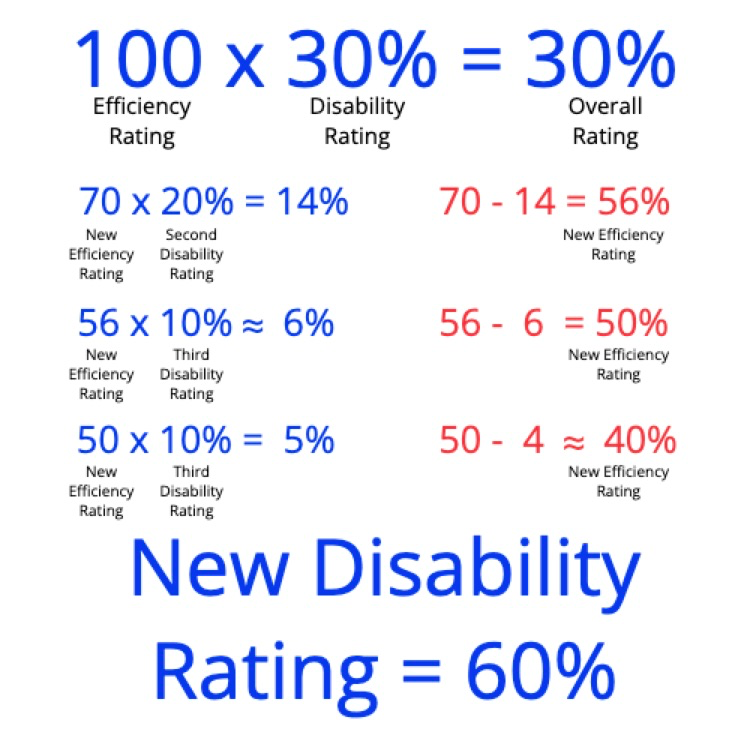Podcast: Play in new window | Download
Subscribe: Apple Podcasts | RSS
Table of Contents
If I asked you the answer to 30 + 20, you would quickly tell me 50. And you would be right in just about every instance. But for veterans with service-connected disability ratings, the math doesn’t always work out quite so easily.
In fact, 30 + 20 might only equal 44, which rounds down to 40. Or it might equal 48.4, which rounds up to 50. Confused yet? Welcome to the world of VA Math.
VA disability ratings determine your access to disability benefits and compensation. To ensure you’re receiving the right benefits, learning how to calculate your combined rating is vital. An incorrect disability rating can mean losing out on hundreds to thousands of dollars per year.
Veterans: Are you under 90% rated?
Winning approval for military service-connected injuries and illnesses can be a challenging process. Be confident that you’re getting the compensation that you medically, legally, and ethically qualify for.
Answer a few quick questions to get the most accurate veteran disability rating that your conditions warrant here.
Overview of VA Disability Ratings
VA disability ratings represent the degree of impairment or disability a veteran experiences as a result of service-connected injuries or illnesses. The ratings are assigned on a scale from 0% to 100% in increments of 10%, with higher ratings indicating a more severe disability.
A good way to understand this is to consider how disabilities affect your ability to perform work and daily activities. To do this, the VA looks at how your disability affects your overall efficiency.
If you have no major service-connected injuries or illnesses, your efficiency is rated at 100%. You will always begin with an efficiency rating of 100, and each new disability gives you a new baseline.
The VA uses your efficiency rating as a basis to rate multiple disabilities.
How the VA Rates Multiple Disabilities
Each injury or illness is rated by itself, without consideration of other illnesses or injuries, unless they contribute to further injuries. The VA also considers whether or not the injuries are bilateral, which means they affect limbs on both sides of the body (for example, disabilities on both arms or both legs). All of your disability ratings are listed in descending order, then the VA math begins.
Let’s work through an example.
Say you had an arthroscopic surgery for the knee injury but still have some pain and stiffness. The VA could grant you a 10% service-connected disability rating. The VA determines this rating by looking at your efficiency, which it calls 90%.
It seems like you can just subtract the 10% from 100% and come up with 90%. But the VA does the math differently:

This example of the veteran with a knee injury covers the most basic situation – a single disability rating. However, things get more interesting when you have more than one disability rating.
Let’s run through an example, building on the previous profile.
Our veteran now has the following service-connected disability ratings:
- 10% rating for his right knee (basic above example)
- 30% rating for a back injury
- 20% rating for a right shoulder injury
- 10% for hearing loss
Do Disabled Veterans Qualify for VA Home Loans?
Disabled veterans who have VA loan entitlement are eligible for a VA home loan. However, all active-duty military and veteran borrowers have multiple requirements to hit in order to fully qualify for a VA home loan, including meeting the service standards and a lender’s specific credit score minimum to residual income and acceptable debt-to-income ratio.
Check if you meet the official VA loan requirements here.
Calculate Combined Disability Ratings Using VA Math
The VA uses a descending efficiency scale for its calculations. The VA will give each injury or illness a numerical rating.
To determine the overall rating, the VA will start with the highest rating and then work its way down.
- Start by ordering the disabilities in descending order. In the example above, we have ratings of 30%, 20%, 10% and 10%. We start with the 30%, then factor in the 20%, the 10% then the final 10%.
- Multiply your efficiency rate of 100 by your disability rating. In this case, you would multiply 30% times 100 and get 30.
- Subtract the result from your original rating. For the example, subtract 30 from 100 and come up with 70. 30% is your new disability rating, while 70% is your new efficiency rating.
- Repeat the process for each additional rating: In this example, you will repeat the process for each additional rating until reaching a final rating of combined disability rating of 60%.

VA Combined Rating Table
The math can be a bit confusing if you try to do it manually; that’s where this VA combined ratings table may be helpful.
| 10 | 20 | 30 | 40 | 50 | 60 | 70 | 80 | 90 | |
|---|---|---|---|---|---|---|---|---|---|
| 19 | 27 | 35 | 43 | 51 | 60 | 68 | 76 | 84 | 92 |
| 20 | 28 | 36 | 44 | 52 | 60 | 68 | 76 | 84 | 92 |
| 21 | 29 | 37 | 45 | 53 | 61 | 68 | 76 | 84 | 92 |
| 22 | 30 | 38 | 45 | 53 | 61 | 69 | 77 | 84 | 92 |
| 23 | 31 | 38 | 46 | 54 | 62 | 69 | 77 | 85 | 92 |
| 24 | 32 | 39 | 47 | 54 | 62 | 70 | 77 | 85 | 92 |
| 25 | 33 | 40 | 48 | 55 | 63 | 70 | 78 | 85 | 93 |
| 26 | 33 | 41 | 48 | 56 | 63 | 70 | 78 | 85 | 93 |
| 27 | 34 | 42 | 49 | 56 | 64 | 71 | 78 | 85 | 93 |
| 28 | 35 | 42 | 50 | 57 | 64 | 71 | 78 | 86 | 93 |
| 29 | 36 | 43 | 50 | 57 | 65 | 72 | 79 | 86 | 93 |
| 30 | 37 | 44 | 51 | 58 | 65 | 72 | 79 | 86 | 93 |
| 31 | 38 | 45 | 52 | 59 | 66 | 72 | 79 | 86 | 93 |
| 32 | 39 | 46 | 52 | 59 | 66 | 73 | 80 | 86 | 93 |
| 33 | 40 | 46 | 53 | 60 | 67 | 73 | 80 | 87 | 93 |
| 34 | 41 | 47 | 54 | 60 | 67 | 74 | 80 | 87 | 93 |
| 35 | 42 | 48 | 55 | 61 | 68 | 74 | 81 | 87 | 94 |
| 36 | 42 | 49 | 55 | 62 | 68 | 74 | 81 | 87 | 94 |
| 37 | 43 | 50 | 56 | 62 | 69 | 75 | 81 | 87 | 94 |
| 38 | 44 | 50 | 57 | 63 | 69 | 75 | 81 | 88 | 94 |
| 39 | 45 | 51 | 57 | 63 | 70 | 76 | 82 | 88 | 94 |
| 40 | 46 | 52 | 58 | 64 | 70 | 76 | 82 | 88 | 94 |
| 41 | 47 | 53 | 59 | 65 | 71 | 76 | 82 | 88 | 94 |
| 42 | 48 | 54 | 59 | 65 | 71 | 77 | 83 | 88 | 94 |
| 43 | 49 | 54 | 60 | 66 | 72 | 77 | 83 | 89 | 94 |
| 44 | 50 | 55 | 61 | 66 | 72 | 78 | 83 | 89 | 94 |
| 45 | 51 | 56 | 62 | 67 | 73 | 78 | 84 | 89 | 95 |
| 46 | 51 | 57 | 62 | 68 | 73 | 78 | 84 | 89 | 95 |
| 47 | 52 | 58 | 63 | 68 | 74 | 79 | 84 | 89 | 95 |
| 48 | 53 | 58 | 64 | 69 | 74 | 79 | 84 | 90 | 95 |
| 49 | 54 | 59 | 64 | 69 | 75 | 80 | 85 | 90 | 95 |
| 50 | 55 | 60 | 65 | 70 | 75 | 80 | 85 | 90 | 95 |
| 51 | 56 | 61 | 66 | 71 | 76 | 80 | 85 | 90 | 95 |
| 52 | 57 | 62 | 66 | 71 | 76 | 81 | 86 | 90 | 95 |
| 53 | 58 | 62 | 67 | 72 | 77 | 81 | 86 | 91 | 95 |
| 54 | 59 | 63 | 68 | 72 | 77 | 82 | 86 | 91 | 95 |
| 55 | 60 | 64 | 69 | 73 | 78 | 82 | 87 | 91 | 96 |
| 56 | 60 | 65 | 69 | 74 | 78 | 82 | 87 | 91 | 96 |
| 57 | 61 | 66 | 70 | 74 | 79 | 83 | 87 | 91 | 96 |
| 58 | 62 | 66 | 71 | 75 | 79 | 83 | 87 | 92 | 96 |
| 59 | 63 | 67 | 71 | 75 | 80 | 84 | 88 | 92 | 96 |
| 60 | 64 | 68 | 72 | 76 | 80 | 84 | 88 | 92 | 96 |
| 61 | 65 | 69 | 73 | 77 | 81 | 84 | 88 | 92 | 96 |
| 62 | 66 | 70 | 73 | 77 | 81 | 85 | 89 | 92 | 96 |
| 63 | 67 | 70 | 74 | 78 | 82 | 85 | 89 | 93 | 96 |
| 64 | 68 | 71 | 75 | 78 | 82 | 86 | 89 | 93 | 96 |
| 65 | 69 | 72 | 76 | 79 | 83 | 86 | 90 | 93 | 97 |
| 66 | 69 | 73 | 76 | 80 | 83 | 86 | 90 | 93 | 97 |
| 67 | 70 | 74 | 77 | 80 | 84 | 87 | 90 | 93 | 97 |
| 68 | 71 | 74 | 78 | 81 | 84 | 87 | 90 | 94 | 97 |
| 69 | 72 | 75 | 78 | 81 | 85 | 88 | 91 | 94 | 97 |
| 70 | 73 | 76 | 79 | 82 | 85 | 88 | 91 | 94 | 97 |
| 71 | 74 | 77 | 80 | 83 | 86 | 88 | 91 | 94 | 97 |
| 72 | 75 | 78 | 80 | 83 | 86 | 89 | 92 | 94 | 97 |
| 73 | 76 | 78 | 81 | 84 | 87 | 89 | 92 | 95 | 97 |
| 74 | 77 | 79 | 82 | 84 | 87 | 90 | 92 | 95 | 97 |
| 75 | 78 | 80 | 83 | 85 | 88 | 90 | 93 | 95 | 98 |
| 76 | 78 | 81 | 83 | 86 | 88 | 90 | 93 | 95 | 98 |
| 77 | 79 | 82 | 84 | 86 | 89 | 91 | 93 | 95 | 98 |
| 78 | 80 | 82 | 85 | 87 | 89 | 91 | 93 | 96 | 98 |
| 79 | 81 | 83 | 85 | 87 | 90 | 92 | 94 | 96 | 98 |
| 80 | 82 | 84 | 86 | 88 | 90 | 92 | 94 | 96 | 98 |
| 81 | 83 | 85 | 87 | 89 | 91 | 92 | 94 | 96 | 98 |
| 82 | 84 | 86 | 87 | 89 | 91 | 93 | 95 | 96 | 98 |
| 83 | 85 | 86 | 88 | 90 | 92 | 93 | 95 | 97 | 98 |
| 84 | 86 | 87 | 89 | 90 | 92 | 94 | 95 | 97 | 98 |
| 85 | 87 | 88 | 90 | 91 | 93 | 94 | 96 | 97 | 99 |
| 86 | 87 | 89 | 90 | 92 | 93 | 94 | 96 | 97 | 99 |
| 87 | 88 | 90 | 91 | 92 | 94 | 95 | 96 | 97 | 99 |
| 88 | 89 | 90 | 92 | 93 | 94 | 95 | 96 | 98 | 99 |
| 89 | 90 | 91 | 92 | 93 | 95 | 96 | 97 | 98 | 99 |
| 90 | 91 | 92 | 93 | 94 | 95 | 96 | 97 | 98 | 99 |
| 91 | 92 | 93 | 94 | 95 | 96 | 96 | 97 | 98 | 99 |
| 92 | 93 | 94 | 94 | 95 | 96 | 97 | 98 | 98 | 99 |
| 93 | 94 | 94 | 95 | 96 | 97 | 97 | 98 | 99 | 99 |
| 94 | 95 | 95 | 96 | 96 | 97 | 98 | 98 | 99 | 99 |
Source: 38 CFR 4.25 – Combined ratings table.
How to Read the VA Combined Disability Table
First, list all your disabilities in descending order. To begin, take the highest disability rating and find that number in the left column. That is your starting point. Then, navigate across the row to the intersecting point with your next highest disability rating. This is your combined rating for these two disabilities.
If these are your only two disabilities, you can round to the nearest number divisible by 10. The VA rounds final ratings to the nearest 10 (ex: 56% disability would be 60%, 54% would be 50%).
If you have more than two disabilities, repeat this process until you have run the numbers for all disability ratings. Using the table for the previous example above, your new combined rating should be 55%, which rounds up to 60%.
It’s great to know how to use the combined rating table so you can verify your disability rating for yourself. But it’s also nice to be able to use our VA Disability calculator that takes all these factors into consideration.
How Bilateral Disabilities Affect Your Rating
There is one more issue we need to consider that can greatly impact your rating: the bilateral factor.
What is the Bilateral Factor? The bilateral factor applies to veterans living with disabilities that affect corresponding body parts (for example, both eyes, both arms, both legs, etc.). The disabilities don’t have to mirror each other. The VA considers separate injuries affecting the left foot and the right knee, for example, to be bilateral.
For bilateral injuries, the VA combines the individual rates and adds 10% of the combined amount to the total percentage. It uses the new total as one rating when calculating the rest of your combined total.
Example Using the Bilateral Factor
Let’s stick with the example profile from above, but let’s add another knee disability, one on each leg. In total, we’re working with:
- 30% rating for a back injury
- 20% rating for a right shoulder injury
- 10% rating for right knee
- 10% for left knee
- 10% for hearing loss
The two knee injuries would qualify for the bilateral factor.
In this example, the disability rating for each knee is 10%, but when combined, they equal 21%, according to the combined rating table above. Here is how it works:
A 10% disability combined with another 10% disability = 19%
Then, you add 10% of 19, or 1.9%
19% + 1.9% = 20.9%, which rounds up to 21%
The combined rating for both knees is now 21%, and the VA will use 21% as the rating for those disabilities. Keep in mind it is possible to have more than two disabilities combined in the bilateral factor.
Using the combined rating table above, start with the 21% rating and the 30% rating. This takes us to 45. Follow the left column down to 45 and find where it intersects with 20. You get 56.
Repeat the process for 56 and 10, and you get 60. The overall service-connected disability rating for this veteran is exactly 60%.
The previous example using the table was 55%, rounded up to 60%, and this example was exactly 60% without rounding. As your disability percentage increases, it takes more disabilities with higher ratings to move the needle.
How to Increase Your VA Disability Rating
If you feel your VA rating does not accurately reflect the impact your service-connected disability has on your life, you can try to get the VA to increase your disability rating.
One way to do this is to file an appeal.
If you’re still within a year of the VA’s decision on your initial claim, you can file a Notice of Disagreement to kick off the formal appeal process. You’ll use the Notice of Disagreement form to declare what you disagree with and indicate how you’d like your appeal to proceed.
If you are outside of the one-year period for a notice of disagreement, you can file a new claim for an increased rating. Be sure to include any new evidence, medical opinions or documentation showing that your condition has worsened or is worse than what the VA previously rated it.
If your condition has worsened to the point that you can not work, you can file for TDIU or “total disability based on individual unemployability.” When in doubt, you can always reach out to a Veterans Service Officer at a Veterans Service Organization. VSOs will help you with your claim free of charge.
Veterans: Are you under 90% rated?
Winning approval for military service-connected injuries and illnesses can be a challenging process. Be confident that you’re getting the compensation that you medically, legally, and ethically qualify for.
Answer a few quick questions to get the most accurate veteran disability rating that your conditions warrant here.





Comments:
About the comments on this site:
These responses are not provided or commissioned by the bank advertiser. Responses have not been reviewed, approved or otherwise endorsed by the bank advertiser. It is not the bank advertiser’s responsibility to ensure all posts and/or questions are answered.
Kevin Leopard says
Nice site! Well Done. I am UI and I just 3+ mos ago sent in app for Aid and Attendance. I am in Thailand. The V,A. sent me to see a VES exam here and I was able to go since we have a wheel chair and the Dr gave me 100% along with my Neurologist giving me 100% via the original application. So there were 2 exams.
Then since I have a lot of time being in bed quite a bit I learned about special monthly compensation and saw that adding my PTSD (The Psychologist I saw here gave me 100% PTSD. 1 exam) I have PTSD pretty bad yet I do not get out much anymore. However it does exist.
I was in the Navy, a diver Training) Medical Separation. I have a 70% service connected disability rating and they gave me UI. Also in 1979 we were at war in Afghanistan. So the serving 1 day during a wartime period is also satisfied. So I was wondering about what I will receive, AnA or the SMCL..
If I were to receive an additional 60%+ rating, I may get to smc L. (what do you think pls?) I contacted my V.A. and told them that getting the smc L would be enough. I think that AnA and the SMC at same time or together would be to much and unfair. I have 3 caregivers. Can I also get one to be a “Primary Caregiver” and get money for Her as well?
I have not heard back from the V.A. yet. I think the poor Souls are getting Hammered due to the influx of the PACT act applications.. anyway I thought I would ask your opinion on this situation as you appear to have knowledge.
Pls let me know and Thx!
Kevin